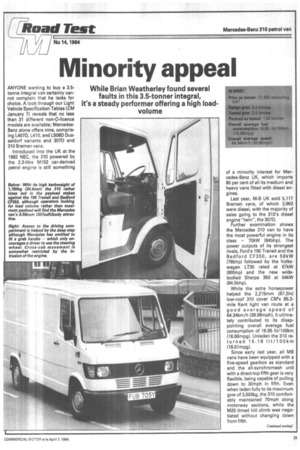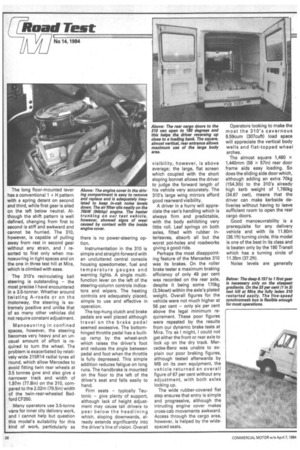Minority appeal
Page 27

Page 28

Page 29

If you've noticed an error in this article please click here to report it so we can fix it.
ANYONE wanting to buy a 3.5 tonne integral van certainly cannot complain that he lacks for choice. A look through our Light Vehicle Specification Tables (CM January 7) reveals that no less than 31 different non-O-licence models are available; MercedesBenz alone offers nine, compris ing L407D, L410, and 1.508D Dusseldorf variants and 307D and 310 Bremen vans.
Introduced into the UK at the 1982 NEC, the 310 powered by the 2.3-litre M102 car-derived petrol engine is still something of a minority interest for Mercedes-Benz UK, which imports 80 per cent of all its medium and heavy vans fitted with diesel engines.
Last year, M-B UK sold 5,117 Bremen vans, of which 3,963 were diesel, with the majority of sales going to the 310's diesel engine "twin", the 307D. • Further examination shows the Mercedes 310 van to have the most powerful engine in its class — 70kW (94bhp). The power outputs of its strongest rivals, Ford's 190 Transit and the Bedford CF350, are 58 kW (78bhp) followed by the Volkswagen LT35 rated at 67kW (90bhp) and the new widebodied Sherpa 350 at 64kW (84.5bhp).
While the extra horsepower helped the 2,215mm (87.2in) low-roof 310 cover CM's 85.3mile Kent light van route at a good average speed of 64.34km/h (39.98mph), it ultimately contributed to its disappointing overall average fuel consumption of 16.95 lit/100km (16.66mpg). Unladen the 310 returned 15.18 lit/ 100km (18.61mpg).
Since early last year, all MB vans have been equipped with a five-speed gearbox as standard and the all-synchromesh unit with a direct-top fifth gear is very flexible, being capable of pulling down to 30mph in fifth. Even when laden fully to its maximum gvw of 3,500kg, the 310 comfortably maintained 70mph along motorway sections, while the M20 timed hill climb was negotiated without changing down from fifth. The long floor-mounted lever has a conventional 1 + H pattern with a spring detent on second and third, while first gear is sited on the left below neutral. Although the shift pattern is well defined, changing from first to second is stiff and awkward and cannot be hurried. The 310, however, is capable of pulling away from rest in second gear without any strain, and I resorted to first only when manoeuvring in tight spaces and on the one in three test hill at Mira, which is climbed with ease.
The 310's recirculating ball steering is outstanding — the most precise I have encountered in a 3.5-tonner. Whether around twisting A-roads or on the motorway, the steering is extremely positive and unlike that of so many other vehicles did not require constant adjustment.
Manoeuvring in confined spaces, however, the steering becomes very heavy and an unusual amount of effort is required to turn the wheel. The problem is exacerbated by relatively wide 215R14 radial tyres all round, which allow Mercedes to avoid fitting twin rear wheels at 3.5 tonnes gvw and also give a narrower track and width of 1.97m (77.8in) on the 310, compared to the 2.02m (79.5in) width of the twin-rear-wheeled Bedford CF350.
Many operators use 3.5-tonne vans for inner city delivery work, and I cannot help but question this model's suitability for this kind of work, partictularly as there is no power-steering option.
Instrumentation in the 310 is simple and straight-forward with an uncluttered central console housing speedometer, fuel and temperature gauges and warning lights. A single multifunction lever on the left of the steering-column controls indica tors and wipers. The heating controls are adequately placed, simple to use and effective in operation.
The top-hung clutch and brake pedals are well placed although travel on the brake pedal seemed excessive. The bottomhinged throttle pedal has a builtup ramp by the wheel-arch which raises the driver's foot and reduces the angle between pedal and foot when the throttle is fully depressed. This simple addition reduces fatigue on long runs. The handbrake is mounted on the floor to the left of the driver's seat and falls easily to hand.
Firm seats — typically Teutonic — give plenty of support, although lack of height adjustment may cause tall drivers to peer below the headlining which, sloping downwards, al ready extends significantly into the driver's line of vision. Overall visibility, however, is above average; the large, flat screen which coupled with the short sloping bonnet allows the driver to judge the forward length of his vehicle very accurately. The 310's large wing mirrors afford good rearward visibility.
A driver in a hurry will appreciate the van's handling which is always firm and predictable, with the body exhibiting very little roll. Leaf springs on both axles, fitted with rubber interleaves, absorb all but the worst pot-holes and roadworks giving a good ride.
Perhaps the most disappointing feature of the Mercedes 310 was its brakes. On the roller brake tester a maximum braking efficiency of only 49 per cent was recorded on the rear axle, despite it being some 170kg (3.34cwt) within the axle's plated weight. Overall figures for the vehicle were not much higher at 56 per cent — only six per cent above the legal minimum requirement. These poor figures were repeated by the results from our dynamic brake tests at Mira. Try as I might, I could not get either the front or rear axle to lock up on the dry track. Mercedes-Benz was unable to explain our poor braking figures, although tested afterwards by MB on its own equipment, the vehicle returned an overall figure of 67 per cent without any adjustment, with both axles locking up.
The wide rubber-covered flat step ensures that entry is simple and progressive, although the intruding engine cover makes cross-cab movements awkward. Access through the cargo area, however, is helped by the wide spaced seats. Operators looking to make the most the 310's cavernous 8.59cum (307cuft) load space will appreciate the vertical body wells and flat-topped wheel arches.
The almost square 1,480 x 1,440mm (58 x 57in) rear door frame aids easy loading. So does the sliding side door which, although adding an extra 70kg (154.31b) to the 310's already high kerb weight of 1,760kg (34.67 cwt), means that the driver can make kerbside de liveries without having to leave sufficient room to open the rear cargo doors.
Good manoeuvrability is a prerequisite for any delivery vehicle and with its 11.60m (38.1ft) turning circle, this model is one of the best in its class and is beaten only by the 190 Transit which has a turning circle of 11.35m (37.2ft).
Noise levels are generally acceptable, although along the motorway a badly fitted nearside door set up an irritating whistle at speeds between 65 and 70mph.
All routine maintenance can be achieved after merely raising the short bonnet and for more serious work the hinged front panel (including grille and headlamps) can be swung up to give access to the radiator or allow engine removal.
Summary The Mercedes 310 van is a steady rather than an outstanding performer. Its interior is workmanlike, the steering is positive and overall the vehicle will appeal to many drivers. However, its 1,760kg (34.67cwt) kerbweight (without driver) is among the highest of any 3.5tonne van and may deter those operators looking for maximum payload potential. On the other hand, the 8.3cum (307cuft) body offers a high load volume.
The powerful engine can run on two-star fuel 191 octane) and with its well chosen ratios makes light work of inter-urban running. Brakes, however, could certainly be improved.
For all its faults, the vehicle has much to recommend it, and if the Mercedes-Benz reputation for extended light vehicle operational life is justified, the 35tonne 310 may yet find its minority appeal growing.




































































































